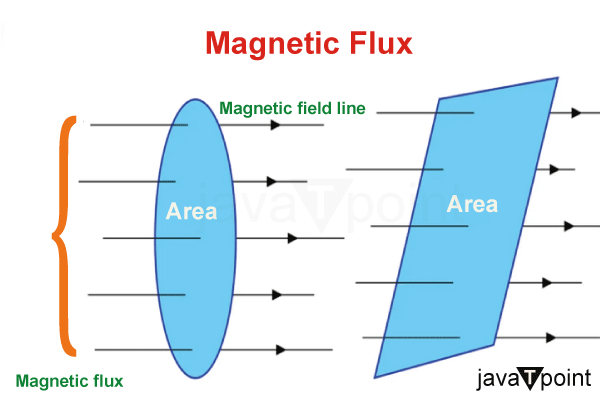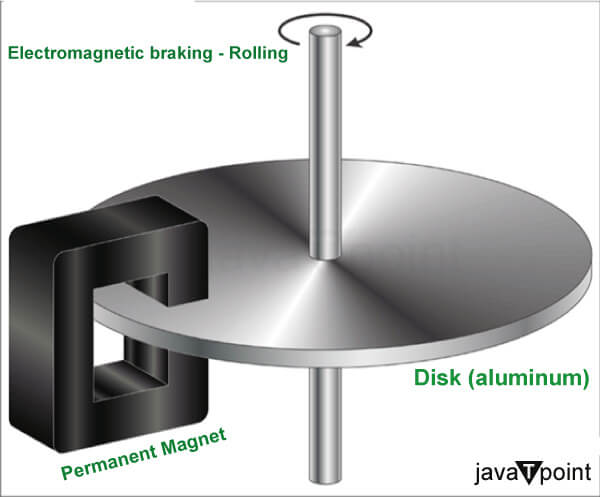Lenz's LawIntroduction:In the realm of electromagnetism, a cornerstone principle helps us understand the intricate relationship between changing magnetic fields and induced electric currents. This principle, known as Lenz's Law, bears the name of the 19th-century Russian physicist Heinrich Lenz, who first formulated its profound implications. Lenz's Law describes the direction of an induced electromotive force (EMF) or current in a circuit due to a changing magnetic field. Before diving into Lenz Law, we need to understand what is meant by the terms Electro-Motive Force (EMF) and Magnetic Flux. Electromotive Force (EMF):Despite its name, EMF isn't actually a "force" in the traditional sense; it's a measure of the potential difference or voltage that drives electric charges to move within a circuit. In simpler terms, EMF is the energy per unit charge that is converted from one form to another, typically from non-electrical forms (like mechanical energy) to electrical energy. For example, think of a battery: when you connect a battery to a circuit, it provides an EMF that pushes electric charges (electrons) through the circuit, allowing it to do work, power devices, or create currents. Changes in magnetic flux induce electromotive force (EMF) in a closed circuit through the process of electromagnetic induction. This phenomenon was discovered by Michael Faraday in the early 19th century. When the magnetic field passing through a closed circuit changes, the magnetic flux through the circuit also changes. This change in magnetic flux, as indicated by Faraday's Law, induces an EMF in the circuit. The induced EMF generates an electric potential difference between different points in the circuit, creating a force that drives electric charges to move. Electrons, which are the charge carriers in most conductors, experience a force due to the induced EMF. This force causes the electrons to move within the conductor, resulting in the flow of an electric current. Magnetic Flux:Magnetic flux is a measure of the total magnetic field passing through a surface or area. It's a way to quantify the strength of a magnetic field as it "flows" through a given area. The concept is similar to how you might measure the amount of water passing through a pipe in a certain time; magnetic flux measures the amount of magnetic field passing through a certain surface. 
Mathematically, magnetic flux (Φ) is calculated by multiplying the strength of the magnetic field (B) by the area (A) through which the field lines pass, and then by the cosine of the angle (θ) between the magnetic field and the normal (perpendicular) to the surface: Φ = B * A * cos(θ) In simpler situations, where the magnetic field is perpendicular to the surface (θ = 0), the formula simplifies to just Φ = B * A. Magnetic flux is important in contexts involving electromagnetic induction, as changes in magnetic flux through a closed circuit can induce an electromotive force (EMF) and, subsequently, an electric current in that circuit, as Faraday's Law of Electromagnetic Induction describes. Changes in magnetic flux can occur due to alterations in magnetic field strength or orientation.
Consider a situation where a magnet is rotated such that its field lines are no longer perpendicular to a coil's surface. The magnetic flux through the coil decreases because the magnetic field component perpendicular to the coil's surface has decreased. Again, this change in magnetic flux induces an EMF and a current in the coil. Lenz's Law:The statement of Lenz's Law is as follows: "The direction of an induced current in a closed circuit will always oppose the change in magnetic flux that produced it." Magnetic flux refers to the amount of magnetic field passing through a given area. When this magnetic flux changes, either due to a change in the strength of the magnetic field or due to a change in the orientation of the magnetic field lines, it induces an electromotive force (EMF) or voltage in a nearby conductor. Lenz's Law asserts that the induced current resulting from the changing magnetic flux will always flow in a direction that opposes the change causing it. In other words, the induced current will generate its own magnetic field that counteracts the initial change in magnetic flux. Example:Imagine you have a coil of wire and a permanent magnet. Moving the magnet toward the coil increases the magnetic field passing through the coil's loops. According to Lenz's Law, the induced current in the coil will create its own magnetic field that opposes the increase in the external magnetic field. This opposing magnetic field tries to push the magnet away, resisting the change that caused it. Similarly, moving the magnet away from the coil decreases the magnetic field passing through the coil's loops. In this case, the induced current in the coil generates a magnetic field that tries to pull the magnet back, again opposing the change that led to its creation. Or Consider a loop of wire connected to a closed circuit. If you have a bar magnet and you rapidly push it into the center of the loop, you're effectively increasing the magnetic field passing through the loop. Lenz's Law comes into play here. The induced current in the loop will flow in a direction that generates a magnetic field opposing the increase in magnetic flux caused by the magnet moving in. Conversely, if you quickly pull the magnet out of the loop, you reduce the magnetic field passing through the loop. Again, Lenz's Law ensures that the induced current will flow in a direction that creates a magnetic field opposing the decrease in magnetic flux caused by the magnet moving out. Conservation of Energy and Lenz's LawThe conservation of energy is a foundational principle in physics that states that energy cannot be created or destroyed but only converted from one form to another. Lenz's Law aligns with this principle by ensuring that when a change occurs in a magnetic field, the energy associated with that change is not lost but rather transformed into electrical energy. For example, when you move a magnet into a coil, you're doing work to change the magnetic flux passing through the coil. According to the conservation of energy, the work you put in must be conserved. Lenz's Law ensures that the energy you input is converted into electrical energy by inducing a current that opposes the change you made. This opposition creates a magnetic field that interacts with the original magnetic field, resisting the change and conserving the energy you initially invested. Applications of Lenz's LawLenz's Law finds practical applications in various areas of science and technology:
Importance of Lenz's LawLenz's Law is pivotal in shaping our understanding of the interactions between magnetic fields, electric currents, and energy conservation. Its importance extends beyond theoretical physics, permeating various technological applications and enhancing our comprehension of the universe's underlying laws. Lenz's Law is intrinsically tied to Faraday's Law of Electromagnetic Induction, forming a cornerstone of electromagnetic interactions. Together, these laws elucidate the intricate dance between changing magnetic fields and induced currents, painting a comprehensive picture of how electric and magnetic phenomena interact. This deeper understanding has led to developing technologies that shape our modern world. 1. Conservation of EnergyAt the heart of Lenz's Law lies the principle of energy conservation. When a change occurs in a magnetic field, the corresponding change in magnetic flux induces an electromotive force (EMF) in nearby conductors. Lenz's Law deftly guides this induced EMF, compelling it to oppose the change in flux that engendered it. Consider the implications of this opposition. When a magnet approaches a coil, the induced current generated by Lenz's Law creates its own magnetic field. This magnetic field counteracts the magnet's movement, thus necessitating the continuous expenditure of external energy to sustain the motion. Therefore, Lenz's Law acts as a custodian of energy conservation, ensuring that the work invested in changing the magnetic flux is not lost but transformed into electrical energy. 2. Maintaining Equilibrium of Physical Systems:Equilibrium in physical systems hinges on a delicate balance between opposing forces. With its directive for induced currents to oppose changes in magnetic flux, Lenz's Law harmonizes with this equilibrium. When a magnetic field undergoes alteration, Lenz's Law dictates the creation of currents that resist the change, effectively stabilizing the system and preventing abrupt disruptions. This equilibrium-preserving quality is particularly evident in scenarios like electromagnetic braking. Lenz's Law facilitates controlled deceleration by inducing opposing currents in moving conductive materials. Similarly, Lenz's Law ensures efficient energy transfer between primary and secondary coils in transformers, maintaining a balance between input and output. 3. Empowering Understanding and Innovation:Lenz's Law's profound role in preserving energy and equilibrium also holds implications for our understanding of electromagnetism. Its integration with Faraday's Law of Electromagnetic Induction constructs a comprehensive framework for comprehending the dynamic interplay between magnetic fields and induced currents. This understanding, in turn, fuels innovation across various fields. Lenz's Law's impact reverberates through our technological landscape, from generators that harness kinetic energy to transformers that redefine voltage levels. Lenz's Law guides engineers and scientists, propelling them to design systems that align with the laws of conservation and equilibrium. Conclusion:Lenz's Law is an indispensable law in electromagnetism and engineering, having theoretical and application physics implications. At its core, Lenz's Law safeguards the energy conservation principle. This principle dictates that energy cannot be created or destroyed; it can only be transformed from one form to another. Lenz's Law ensures that changes in magnetic fields do not result in a net energy loss but rather lead to energy conversion between mechanical and electrical forms. This law also ties into Faraday's Law and dictates the functioning of electromagnetic induction, making it useful for engineers and inventors to understand and implement electromagnetic induction in devices.
Next TopicArchimedes Principle
|
 For Videos Join Our Youtube Channel: Join Now
For Videos Join Our Youtube Channel: Join Now
Feedback
- Send your Feedback to [email protected]
Help Others, Please Share










